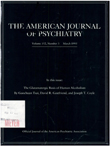Validity of the Dissociative Experiences Scale in screening for multiple personality disorder: a multicenter study
Abstract
OBJECTIVE: The Dissociative Experiences Scale has proved a reliable and valid instrument to measure dissociation in many groups, but its capacity to distinguish patients with multiple personality disorder from patients with other psychiatric disorders has not yet been conclusively tested. METHOD: A discriminant analysis was performed to classify 1,051 subjects as having or not having multiple personality disorder. Another discriminant analysis was performed on a subgroup of 883 subjects more closely representing patients in a typical psychiatric facility in terms of base rates of dissociative disorders. A cutoff score of 30 was also used to classify subjects, and Bayes's theorem, which allows for the calculation of the positive predictive value and the negative predictive value of a screening test, was applied. RESULTS: According to discriminant analysis of the total study group, the scale's sensitivity was 76% and its specificity was also 76%; according to discriminant analysis of the more representative subgroup, the scale's sensitivity was 76% and its specificity was 85%. Use of the cutoff score of 30 produced similar results. Results of the application of Bayes's theorem showed that 17% of the subjects scoring 30 or higher would actually have multiple personality disorder and 99% of those scoring less than 30 would not have multiple personality disorder. CONCLUSIONS: These results indicate that the Dissociative Experiences Scale performs quite well as a screening instrument to identify subjects with multiple personality disorder. In addition, the consistency of responses to scale items across centers indicates that the symptoms reported by patients with multiple personality disorder are highly similar across diverse geographic centers. This consistency supports the reliability and validity of the diagnosis of multiple personality disorder across centers.
Access content
To read the fulltext, please use one of the options below to sign in or purchase access.- Personal login
- Institutional Login
- Sign in via OpenAthens
- Register for access
-
Please login/register if you wish to pair your device and check access availability.
Not a subscriber?
PsychiatryOnline subscription options offer access to the DSM-5 library, books, journals, CME, and patient resources. This all-in-one virtual library provides psychiatrists and mental health professionals with key resources for diagnosis, treatment, research, and professional development.
Need more help? PsychiatryOnline Customer Service may be reached by emailing [email protected] or by calling 800-368-5777 (in the U.S.) or 703-907-7322 (outside the U.S.).



